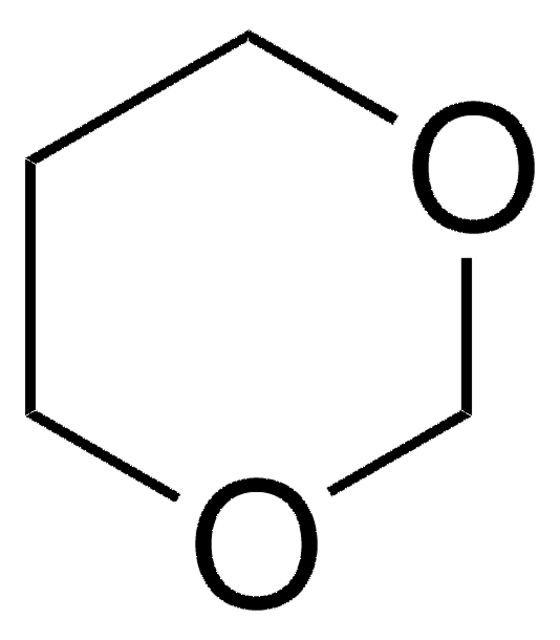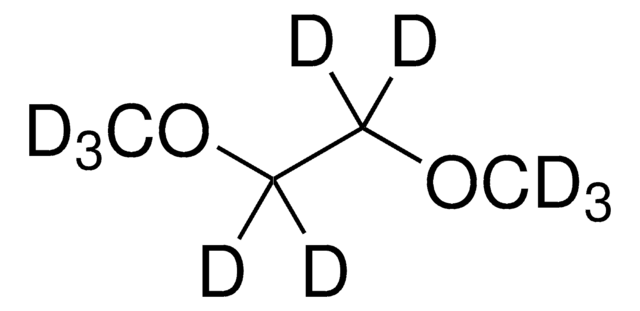271020
1,3-Dioxolan
anhydrous, contains ~75 ppm BHT as inhibitor, 99.8%
Synonym(e):
1,3-Dioxacyclo-pentan, Formaldehyd-ethylenacetal
About This Item
Empfohlene Produkte
Qualität
anhydrous
Qualitätsniveau
Dampfdichte
2.6 (vs air)
Dampfdruck
70 mmHg ( 20 °C)
Assay
99.8%
Form
liquid
Selbstzündungstemp.
525 °F
Enthält
~75 ppm BHT as inhibitor
Verunreinigungen
<0.003% water
<0.005% water (100 mL pkg)
Abdampfrückstand
<0.0005%
Brechungsindex
n20/D 1.401 (lit.)
bp
75-76 °C/1.013 hPa
mp (Schmelzpunkt)
−95 °C (lit.)
Dichte
1.06 g/mL at 25 °C (lit.)
SMILES String
C1COCO1
InChI
1S/C3H6O2/c1-2-5-3-4-1/h1-3H2
InChIKey
WNXJIVFYUVYPPR-UHFFFAOYSA-N
Suchen Sie nach ähnlichen Produkten? Aufrufen Leitfaden zum Produktvergleich
Verwandte Kategorien
Allgemeine Beschreibung
Anwendung
- For the extraction of biodegradable poly(3-hydroxybutyrate) (PHB) from biomass.
- To produce stable dispersions of multiwalled carbon nanotubes (MWCNTs) for the synthesis of modified glassy carbon electrodes.
- To synthesize copolymers (polyoxymethylene) by cationic copolymerization of 1,3,5-trioxane in the presence of maghnite-H+ as a catalyst.
It is also used as a reactant to prepare quasi-solid-state poly(1,3-dioxolane) electrolyte by Sc(OTf)3 catalyzed ring-opening polymerization reactions.
Signalwort
Danger
H-Sätze
Gefahreneinstufungen
Eye Irrit. 2 - Flam. Liq. 2 - Repr. 1B
Lagerklassenschlüssel
3 - Flammable liquids
WGK
WGK 1
Flammpunkt (°F)
26.6 °F - closed cup
Flammpunkt (°C)
-3 °C - closed cup
Persönliche Schutzausrüstung
Eyeshields, Faceshields, Gloves
Hier finden Sie alle aktuellen Versionen:
Besitzen Sie dieses Produkt bereits?
In der Dokumentenbibliothek finden Sie die Dokumentation zu den Produkten, die Sie kürzlich erworben haben.
Kunden haben sich ebenfalls angesehen
Unser Team von Wissenschaftlern verfügt über Erfahrung in allen Forschungsbereichen einschließlich Life Science, Materialwissenschaften, chemischer Synthese, Chromatographie, Analytik und vielen mehr..
Setzen Sie sich mit dem technischen Dienst in Verbindung.











